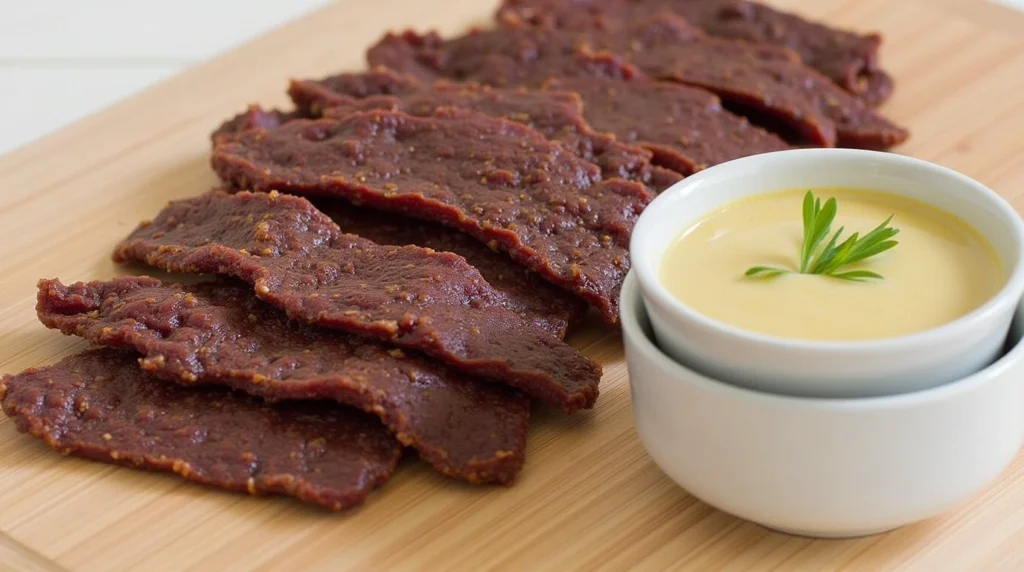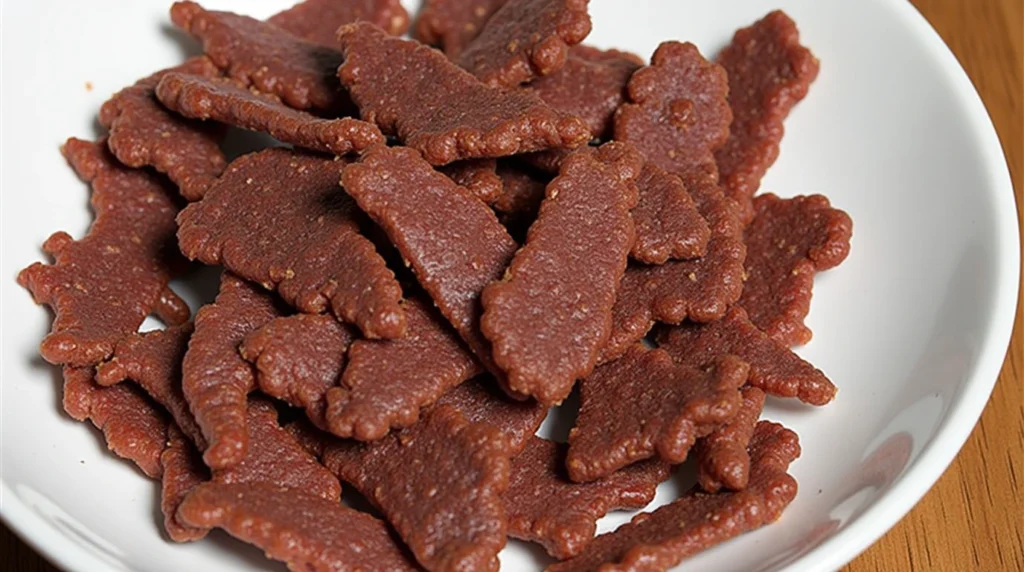I still remember the day my teenage son came home from a camping trip absolutely raving about the ground beef jerky recipe his scout leader had made. “Mom, you HAVE to learn how to make this!” he said, his eyes lighting up as he described the perfect chewy texture and bold flavors. That weekend, I dove headfirst into the world of homemade beef jerky, determined to master this seemingly simple yet incredibly satisfying snack.
What started as a mom’s mission to recreate a camping favorite has become our family’s go-to protein-packed jerky recipe for everything from school lunches to hiking adventures. This recipe is perfect for busy parents looking for healthy snack alternatives, fitness enthusiasts needing portable protein, and anyone following keto or low-carb lifestyles. Unlike traditional whole-muscle jerky that requires expensive cuts of meat, this easy ground beef jerky uses affordable ground beef and delivers consistent results every single time. The best part? You control every ingredient, ensuring no unnecessary preservatives or excessive sodium that you’ll find in store-bought versions.
Recipe Summary
| Detail | Information |
|---|---|
| Prep Time | 30 minutes |
| Cook Time | 4-6 hours (dehydrator) / 3-4 hours (oven) |
| Servings | Makes about 12 ounces of jerky |
| Difficulty Level | Easy |
| Calories | 80 per serving (1 oz) |
| Cuisine | American |
| Course | Snack |
| Description | Tender, flavorful ground beef jerky with perfect chew and bold seasoning |
| Notes | Can be made in dehydrator or oven; stores up to 2 weeks at room temperature |
Why Ground Beef Jerky is Perfect for Your Family

Making ground beef jerky at home offers incredible advantages over both store-bought jerky and traditional whole-muscle jerky. Ground beef is significantly more affordable than the premium cuts typically used for jerky, making this an economical way to create nutritious snacks. The uniform texture of ground meat also ensures consistent results – no more dealing with tough, chewy sections or overly dry pieces that plague homemade whole-muscle jerky.
This dehydrated ground beef jerky is also incredibly versatile. You can adjust the seasoning to your family’s preferences, control the sodium content, and avoid artificial preservatives entirely. Whether you’re packing school lunches, preparing for outdoor adventures, or simply wanting a high-protein snack that won’t spike blood sugar levels, this recipe delivers every time.
Essential Equipment for Making Ground Beef Jerky
Before diving into the recipe, let’s talk about equipment. While a food dehydrator for jerky produces the most consistent results, you can absolutely make excellent jerky using your regular oven. A jerky gun or large zip-lock bag with the corner cut off will help you create uniform strips, though you can also press the meat mixture into a baking sheet and score it into strips.
For the best results, I recommend investing in a basic food dehydrator – they’re surprisingly affordable and open up a whole world of homemade snack possibilities beyond just jerky.
Ingredients for the Best Ground Beef Jerky Recipe

For the Meat Base:
- 2 lbs lean ground beef (90/10 or 93/7) / 900 g
- 1/4 cup soy sauce / 60 ml (use low-sodium for better control)
- 2 tablespoons Worcestershire sauce / 30 ml
- 2 tablespoons brown sugar / 30 g
- 1 tablespoon liquid smoke / 15 ml (essential for authentic jerky flavor)
- 1 teaspoon garlic powder / 3 g
- 1 teaspoon onion powder / 3 g
- 1 teaspoon black pepper / 2 g
- 1 teaspoon smoked paprika / 2 g
- 1/2 teaspoon red pepper flakes / 1 g (adjust to taste)
- 1/2 teaspoon ground coriander / 1 g
- 1 teaspoon salt / 6 g
Optional Flavor Boosters:
- 1 tablespoon honey / 20 g (for slightly sweet jerky)
- 1 teaspoon mustard powder / 2 g
- 1/2 teaspoon cayenne pepper / 1 g (for extra heat)
Step-by-Step Ground Beef Jerky Instructions
Step 1: Prepare Your Ground Beef Jerky Mixture
In a large mixing bowl, combine the lean ground beef with all seasonings. Using your hands (wear gloves if preferred), mix thoroughly until all seasonings are evenly distributed throughout the meat. The mixture should be well-combined but not overworked.
Pro tip: Mix the seasonings in a separate small bowl first, then add to the meat for more even distribution.
Step 2: Form Your Jerky Strips Using the Jerky Gun Method
Load your jerky gun with the seasoned meat mixture. On dehydrator trays lined with non-stick sheets or parchment paper, squeeze out uniform strips about 1/4-inch thick and 6 inches long. Leave space between strips for air circulation.
Pro tip: Keep strips uniform in thickness for even drying – thin spots will over-dry while thick spots may not dry completely.
Step 3: Alternative Strip Formation Without a Jerky Gun
If you don’t have a jerky gun, press the meat mixture onto a parchment-lined baking sheet to about 1/4-inch thickness. Using a knife or pizza cutter, score the meat into strips about 1/2-inch wide. Don’t cut completely through – just create guidelines for breaking apart later.
Step 4: Begin the Dehydrating Process for Perfect Beef Jerky
Set your dehydrator to 155°F (68°C). Place the trays in the dehydrator, ensuring good air circulation between levels. Dehydrate for 4-6 hours, rotating trays every 2 hours for even drying.
Pro tip: Start checking for doneness at the 4-hour mark – jerky should crack when bent but not break completely.
Step 5: Oven Method for Ground Beef Jerky (Alternative)
If using an oven, preheat to the lowest setting (usually 170°F/77°C). Place jerky strips on wire racks set over baking sheets to catch drips. Prop the oven door open slightly with a wooden spoon to allow moisture to escape. Dry for 3-4 hours, checking every hour.
Step 6: Test for Perfect Jerky Doneness
Properly dried jerky should bend and crack without breaking completely. It should feel dry to the touch with no wet or sticky spots. When torn, you shouldn’t see any raw-looking areas in the center.
Step 7: Final Cooling and Storage Preparation
Remove jerky from dehydrator or oven and let cool completely on the trays for 30 minutes. This final cooling allows any remaining moisture to equalize throughout the jerky.
Expert Tips for the Best Homemade Ground Beef Jerky
- Choose the right fat content: Lean ground beef (90/10 or 93/7) is crucial – higher fat content leads to rancid jerky that won’t store well
- Don’t skip the liquid smoke: This ingredient provides the authentic smoky flavor that makes jerky taste like jerky, not just dried seasoned meat
- Maintain consistent thickness: Uniform strips ensure even drying and prevent some pieces from over-drying while others remain underdone
- Control your environment: High humidity days will extend drying time significantly – choose dry days when possible for best results
- Test early and often: Start checking doneness at 4 hours and every 30 minutes thereafter to prevent over-drying
Common Ground Beef Jerky Mistakes to Avoid:
- Using ground beef with too high fat content (leads to rancidity)
- Making strips too thick (prevents proper drying and creates food safety issues)
- Over-seasoning with salt (draws out moisture but can make jerky too salty)
- Not allowing proper air circulation during drying
- Storing jerky before it’s completely cool (creates condensation and spoilage)
Delicious Ground Beef Jerky Variations & Dietary Adaptations
Spicy Jalapeño Ground Beef Jerky
Add 2 finely minced jalapeños, 1 teaspoon cumin, and an extra 1/2 teaspoon cayenne pepper to the base recipe. This creates a jerky with serious heat that builds as you chew.
Sweet Teriyaki Style Jerky
Replace the Worcestershire sauce with teriyaki sauce and add an extra tablespoon of brown sugar. Include 1 teaspoon of ground ginger for authentic Asian-inspired flavors.
Keto-Friendly Ground Beef Jerky
Eliminate the brown sugar and honey, replacing sweetness with an extra 1/2 teaspoon of smoked paprika and 1/4 teaspoon of stevia powder. This version is perfect for ketogenic and low-carb diets.
Ingredient Substitution Guide:
- Soy sauce → Coconut aminos (for gluten-free/soy-free diets)
- Worcestershire sauce → Extra soy sauce + 1 tsp apple cider vinegar
- Liquid smoke → 1 tsp smoked paprika (though flavor will be different)
- Brown sugar → Coconut sugar or sugar-free brown sugar substitute
- Ground beef → Ground turkey or venison (adjust seasonings accordingly)
Proper Storage and Shelf Life of Homemade Jerky
Homemade ground beef jerky storage is crucial for both safety and quality. Properly dried jerky stored in airtight containers at room temperature will last 1-2 weeks. For longer storage, vacuum-sealed jerky can last up to 1 month at room temperature or 6 months in the freezer.
The key to successful storage is ensuring the jerky is completely dry before packaging. Any residual moisture can lead to mold growth and spoilage. If you’re uncertain about dryness, err on the side of caution and dry for an additional hour.
Nutritional Benefits of Homemade Ground Beef Jerky
This high-protein jerky recipe provides approximately 12 grams of protein per one-ounce serving with minimal carbs and fat. Unlike many commercial jerkies loaded with sugars and preservatives, your homemade version offers clean nutrition that supports muscle maintenance, weight management, and sustained energy levels.
The controlled sodium content makes this jerky suitable for those monitoring their salt intake, while the absence of artificial preservatives means you’re feeding your family real food ingredients they can actually pronounce.
Frequently Asked Questions About Ground Beef Jerky
Can I freeze ground beef jerky for longer storage?
Yes! Properly dried jerky freezes beautifully for up to 6 months. Store in freezer-safe bags or vacuum-sealed packages. Thaw at room temperature for 15-20 minutes before eating – it returns to perfect texture quickly.
What’s the best ground beef substitute for this jerky recipe?
Ground turkey works excellently and creates a slightly milder flavor. Ground venison produces exceptional jerky with a rich, gamey taste. For poultry, ensure it’s completely dried as it can be more prone to spoilage than beef.
How do I know if my ground beef jerky is completely dry?
Properly dried jerky should crack when bent sharply but not break in half. There should be no visible moisture, and when torn, the interior should be uniformly dark with no red or pink areas. If in doubt, dry longer.
Can I make this recipe without a dehydrator?
Absolutely! The oven method works well, though you’ll need to prop the door open slightly for moisture to escape. Some people also use box fans with air filters to create DIY dehydrators, though this requires more attention and monitoring.
What’s the shelf life of homemade ground beef jerky compared to store-bought?
Homemade jerky typically lasts 1-2 weeks at room temperature in airtight containers, while commercial jerky often lasts months due to preservatives. However, your homemade version offers superior flavor and nutrition without artificial additives.
Troubleshooting Common Ground Beef Jerky Issues
If your jerky is too salty: Next time, reduce the soy sauce by half and add more liquid smoke or spices for flavor complexity without excess sodium.
If jerky is too tough: This usually indicates over-drying. Monitor more closely next time and test for doneness earlier in the process.
If jerky spoils quickly: This suggests insufficient drying or too high fat content in the ground beef. Choose leaner meat and ensure complete dryness before storage.
If jerky lacks flavor: Ground beef jerky relies heavily on seasonings since the meat flavor is mild. Don’t be afraid to increase spices, and always include liquid smoke for authentic taste.
Creative Ways to Use Ground Beef Jerky
Beyond snacking, this versatile jerky recipe can be incorporated into various dishes. Chop it finely and add to trail mix, crumble over salads for protein boost, or rehydrate in soups and stews for added depth of flavor. Some families even use it as a pizza topping or mix it into scrambled eggs for a protein-packed breakfast.
The uniform texture of ground beef jerky makes it particularly suitable for these creative applications, unlike traditional jerky that can be tough to incorporate into other dishes.
Scaling the Recipe for Large Batches
This recipe scales beautifully for large families or meal prep enthusiasts. Double or triple the ingredients proportionally, but be aware that larger batches may require longer drying times due to increased humidity in your dehydrator or oven. When making large batches, consider processing in multiple smaller loads for more consistent results.
Conclusion
This ground beef jerky recipe has truly transformed our family’s snacking habits and outdoor adventures. There’s something incredibly satisfying about creating wholesome, protein-rich snacks in your own kitchen, knowing exactly what ingredients your family is consuming. The process is surprisingly simple, and the results rival any expensive commercial jerky you’ll find in stores.
The beauty of this recipe lies in its flexibility – you can adjust seasonings to match your family’s preferences, create different flavor profiles for variety, and feel confident about the nutritional value of what you’re serving. Whether you’re packing school lunches, preparing for camping trips, or simply wanting a healthier alternative to processed snacks, this jerky delivers on all fronts.
If you try this recipe, I’d absolutely love to see your results! Please leave a rating below and share your photos on social media – tag me so I can celebrate your jerky-making success. Don’t forget to experiment with the flavor variations I’ve shared – the spicy jalapeño version has become a particular favorite in our household.
For more homemade snack recipes that your family will love, check out my Perfect Beef Shoulder Roast Recipe: Tender, Juicy, and Family-Approved – it pairs perfectly with this jerky for the ultimate outdoor adventure snack combination.
Happy jerky making, and here’s to many delicious, protein-packed adventures ahead!



